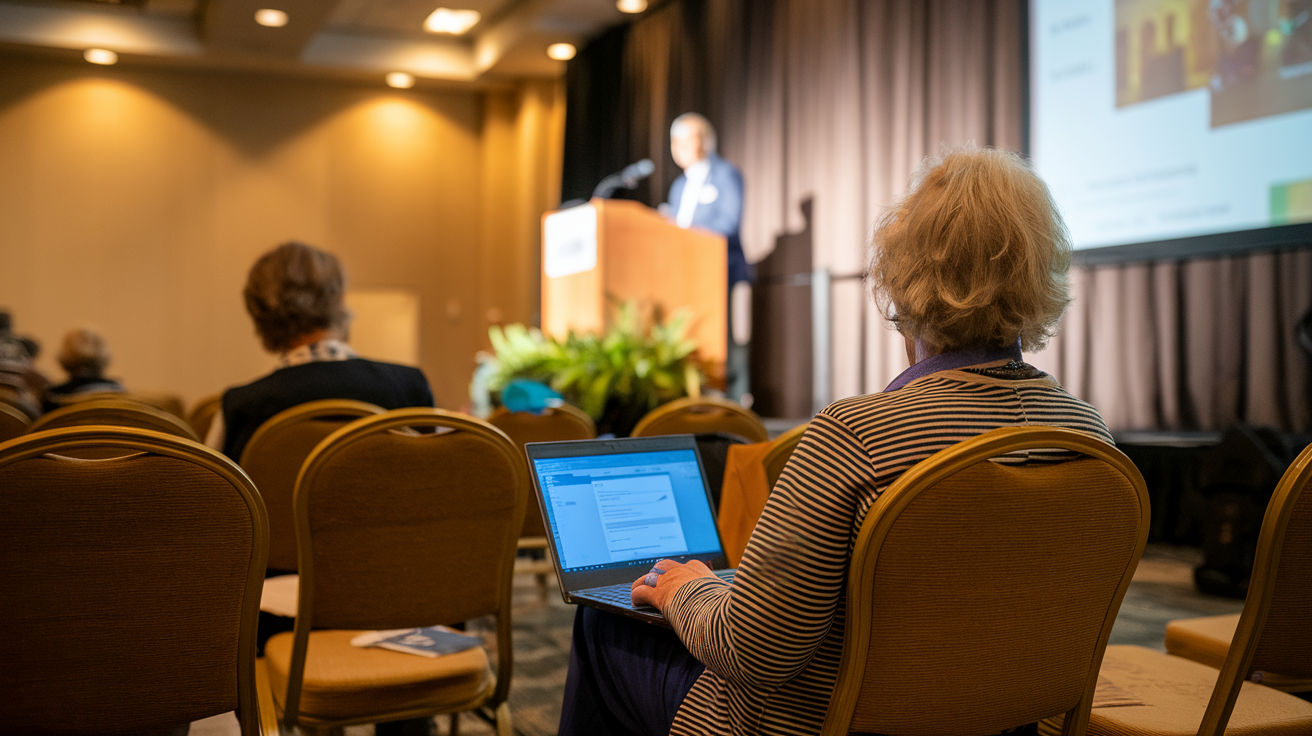This week marks RootsTech week, the largest genealogy conference in the world!
But whether you’re attending this event or planning for any future genealogy gathering, these strategies will transform your experience from overwhelming to game-changing.
Most genealogists attend events unprepared, wasting both time and money. Not you.
You’ve invested (or will invest) in attending. Now invest in preparation.
The difference between leaving a conference with life-changing discoveries versus merely a stack of business cards? Strategy.
Let’s dive in.
In-Person Conference Preparation: The Foundation of Success
Success at genealogy conferences isn’t accidental. It’s engineered.
Think about it. Thousands of genealogists converge in massive venues like Salt Lake Palace. Multiple sessions run simultaneously. Vendor halls stretch for what feels like miles. Without preparation, you’ll spend more time wandering lost than making breakthroughs.
Start planning now. Not tomorrow. Now.
Your research brick walls can crumble in a single conversation with the right expert. But only if you’re prepared to have that conversation.
Strategic Schedule Planning
Most attendees scan the program the night before. Amateurs.
Download the conference program weeks in advance. Study it like your ancestors’ freedom depends on it. Because your research success does.
Create three lists:
- Must-attend sessions (directly addressing your research needs)
- Want-to-attend sessions (valuable but not critical)
- If-time-permits sessions (interesting but optional)
Be ruthless with your time allocation. There are only so many hours.
Want to attend two sessions in the same time block? Check to see if either are being recorded to watch later.
Build in buffer time between sessions. Venues like Salt Lake Palace are massive. You’ll need 10-15 minutes minimum between sessions. Don’t schedule back-to-back sessions in opposite wings of the convention center. You’ll fail.
Pro tip: Identify your top three speakers in advance and prioritize ALL their sessions. Expert-level knowledge compounds.
Packing Like a Pro Genealogist
Comfort equals endurance. Endurance equals results.
Your feet will hate you if you prioritize style over function. Forget fashion. Pack your most comfortable shoes. Period.
Conference rooms oscillate between freezing and sauna-like conditions. Layer. Always layer.
Pack protein-rich snacks. Conference food is overpriced and underwhelming. Your brain needs fuel for maximum retention.
Bring a refillable water bottle. Stay hydrated throughout the day. Your brain needs water to think clearly.
Research Preparation: Your Competitive Advantage
Arrive with specific questions. Vague wonderings get vague answers.
Know your brick walls inside and out. Write down:
- Key dates and locations for your tough research problems
- Which sources you’ve already checked (no need for repeat suggestions)
- Exactly where you got stuck in your research
- Precisely what you need to find next
Practice describing your research challenges clearly and quickly. When you meet someone who researches the same area, you’ll make an impression with your clear questions.
Before DNA-related workshops, make sure your results are already uploaded and processed. You don’t want to waste valuable learning time on basic setup steps.
Prepare to take detailed notes about any suggestions you receive. Experts may not have time to review your materials in depth, but their quick insights can point you in valuable new directions.
Navigating Massive Venues Like a Local
Arrive 45 minutes early on day one. Walk the entire venue. Create mental landmarks. Identify shortcuts.
Locate these essentials immediately:
- Quiet research corners
- Less-crowded restrooms
- Reliable WiFi zones
- Charging stations
- Water fountains
- First aid stations
Download the conference app. Master it before arrival. The app typically shows real-time room changes and cancellations.
At RootsTech specifically, plan your Family History Library visits strategically. Mornings before the conference or evenings after sessions end offer fewer crowds.
Vendor Hall Mastery
Set a firm budget before entering. Write it down. Vendor halls are designed to separate you from your money.
Visit the vendor hall with purpose, not to browse. Browsing costs you strategically valuable time.
For software demonstrations, schedule appointments early. The best time slots vanish quickly.
Ask vendors these questions:
- “What makes your product unique from competitors?”
- “What’s your update schedule?”
- “How does your customer support work?”
- “Do you offer ongoing education?”
Take photos of promising products instead of collecting brochures. Less weight, better organization. Save a tree.
Most vendors offer conference-exclusive discounts. But don’t buy immediately. Note the offer and decide on the final day after evaluating all options.
Strategic Networking
Conferences are 50% content, 50% connections. Maybe more.
Prepare your introduction. “Hi, I’m researching German immigrants to Pennsylvania in the 1740s” beats “Hi, I’m John” every time.
When approaching speakers after sessions, be specific: “Your point about Prussian military records was fascinating. I’m struggling with finding my ancestor’s regiment. Could you suggest a starting point?”
Specific questions get specific answers.
Join Special Interest Groups (SIGs) even if they seem tangential to your research. Cross-pollination of ideas often breaks down stubborn research walls.
Document new contacts immediately. Note where you met them and what you discussed. Memory fails; notes don’t.
At RootsTech, attend cultural celebration events even if they don’t directly relate to your heritage. The connections formed through shared appreciation open unexpected doors.
Maximizing Online Workshops and Virtual Conferences
Physical attendance isn’t the only way to win. Virtual conferences demolish barriers.
Your home setup determines your success rate. Create a command center. Not a casual viewing station.
Test your internet connection 24 hours before the event starts. Run a speed test. If it’s below 25 Mbps, contact your provider or find alternative location. Technical issues destroy momentum.
Create a distraction-free zone. Tell family members you’re unavailable. Put pets in another room. Silence notifications. Your focus determines your results.
Prepare physically: water bottle, notebook, snacks, and backup power sources within arm’s reach. Getting up breaks your concentration.
Digital Engagement Strategies
Passive viewers get passive results. Active participants get breakthroughs.
If live chats are available, enter the chat immediately. Introduce yourself and your research interests. Digital connections start before the first slide appears.
Prepare questions in advance for each session. When the Q&A opens, you’ll be ready while others scramble.
Screenshot key slides (if allowed) instead of frantic note-taking. This keeps your attention on the content instead of your keyboard.
Follow presenters on social media during breaks. Engage with their content. Build relationships digitally. Visibility creates opportunity.
Balancing Live and Recorded Content
Most virtual conferences offer recordings. This changes everything.
Strategically choose which sessions to watch live versus recorded. Live sessions should be those with:
- Interactive components
- Limited replay availability
- Q&A opportunities you need
- Networking potential
Create a viewing calendar for recorded content. Schedule it like appointments. Without deadlines, those recordings will collect digital dust.
Implement one technique from each recording before watching the next. Application beats accumulation.
Post-Conference Action Plan
Most attendees feel motivated during conferences but return to old habits immediately after. Momentum dies without structure.
Within 48 hours of the conference ending, schedule three 2-hour blocks for implementation. Put them on your calendar now.
Create a “Top 10 Actions” list. Focus on techniques with immediate ROI. Quick wins fuel long-term momentum.
Digitize all handwritten notes immediately. Tag them by research line, geography, and methodology. Searchable notes become usable notes.
For every new technique learned, identify one specific research problem to apply it to. Concrete application cements learning.
Continuing the Connections
The conference ends. The relationships shouldn’t.
Send personalized follow-up emails to key contacts within one week. Reference specific conversations you had. Generic follow-ups get generic results.
Join Facebook groups and online communities mentioned during the conference. Extend relationships beyond the event timeline.
Schedule virtual coffee chats with two or three most valuable connections within 30 days. Deepen relationships while the connection is fresh.
Share your implementation results with speakers and fellow attendees. Success creates more connection opportunities.
Conference Types: Choose Wisely
Not all conferences deliver equal value. Your time demands strategic allocation.
Large international conferences like RootsTech offer breadth. Regional conferences deliver depth. Choose based on your current needs.
Rootstech at the Salt Palace is also walking distance from the Family Search Library, so factor that into your decision.
Large conferences overwhelm without preparation but offer unmatched networking. Small conferences provide intimate access to experts but narrower scope.
International conferences expose you to research methodologies you’d never encounter locally. Regional conferences ground you in applicable local resources.
Virtual conferences eliminate travel costs but demand self-discipline. In-person events force focused attendance but require larger investment.
Planning Your Conference Future
Evaluate conferences immediately after attending. Rate them on:
- Applicable content gained
- Valuable connections made
- Research breakthroughs achieved
- Overall ROI (return on investment)
Budget annually for conference attendance. Plan 6-12 months ahead for major events. Early registration discounts often reach 30-40%.
Consider volunteering. Most conferences offer significant discounts or free attendance for volunteers. Plus, you’ll gain insider access.
Combine conference attendance with research trips. Extend your RootsTech stay to research at the Family History Library. Stack value.
The genealogists who make the most breakthroughs aren’t necessarily the smartest researchers. They’re the most strategic conference attendees.
Apply what you’ve learned here to your next event. Watch your research accelerate. Your ancestors are waiting to be found. And you just got better at finding them.
One final thought to leave you with.
Information without implementation is just entertainment. Don’t just read this. Use it. Your ancestors deserve nothing less.
Write that down.
Happy RootsTech week!



Hi! My experience with “walking the floor” at conferences & trade fairs: bring an easy-to-carry smallish notebook (5″x7″ or 6″x8″) with a HARD cover/backing so you can easily write down important info even without a surface to lean on. This has helped me many times.
Wow! This is eye-opening and such useful, organized information. Thank you for compiling this.